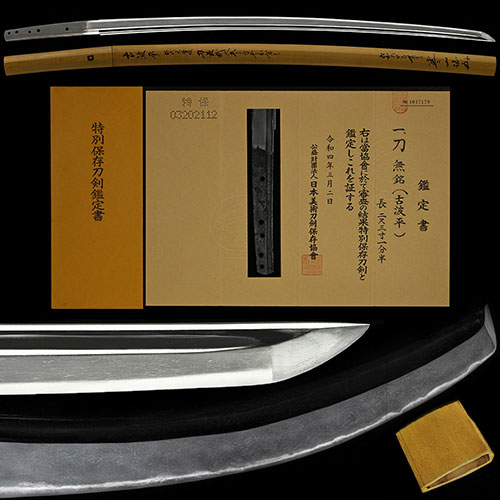
古波平 刀 Konaminohira Katana
No.805100古波平 平安時代元暦頃 食い違い二十刃掛り輝く沸が頻りにつき沸筋掛る古雅な趣の優品 二尺三寸一分Konaminohira Late Heian period, Around Genryaku period, Kuichigai, Nijuba-kakari, Shining Nie entered frequently, Niesuji-kakaru, A masterpiece of elegant style 70.1cm
- 極めKiwame
- 古波平Konaminohira
- 登録証Registration
- 埼玉県 Saitama 令和3年11月1日 11/1/3(Reiwa)
- 時代Period
- 平安末期元暦頃 Late Heian Period, around Genryaku Period
- 法量Size
-
刃長 70.1cm (二尺三寸一分) 反り 1.3cm
元幅 2.8cm 先幅 1.6cm 元重 0.50cm 鎬厚 0.53cm 先重 0.45cm 鋒長 2.6cm 茎長 17.0cm 重量 433gHachou 70.1cm (二尺三寸一分) Sori 1.3cm
Moto-Haba 2.8cm Saki-Haba 1.6cm Moto-Kasane 0.50cm Shinogi-Thikess 0.53cm Saki-Kasane 0.45cm Kissaki-Chou 2.6cm Nakago-Chou 17.0cm Weight 433g - 国Country
- 薩摩Satsuma
- 姿Shape
- 鎬造、庵棟、身幅尋常、反りやや浅く、腰反りつき、小鋒。Shinogidukuri, Iorimune, Standard Mihaba, Slightly shallow Sori, Koshizori-tsuki, Small-Kissaki
- 鍛Kitae
- 板目肌に、流れ肌交じり、肌立ち、地沸微塵につく。Itamehada, Mixed Nagarehada, Hadatachi, Jinie entered finely
- 刃文Hamon
- 細直刃に、小互の目交じり、食い違い・ほつれ・湯走り・二十刃掛り、沸よくつき、匂口明るい。Hososuguha, Mixed small-genome, Kuichigai, Hotsure, Yubashiri, Nijuba-kakari, Nie entered well, Nioikuchi is bright.
- 帽子Boushi
- 直ぐに小丸。Suguni-Komaru
- 茎Nakago
- 大磨上、先栗尻、鑢目切、目釘孔五。Ohsuriage, Sakikurijiri, Yasurimegiri, Mekugiana are five(5)
- ハバキHabaki
- 銀無垢金色絵一重。Gin-Muku, Single Kiniroe (Solid silver with one layer of gold painting.)
- 説明Drscription
- 波平鍛冶は、薩摩国谷山郡波平の地で鍛刀した一派で、平安中期永延の頃に正国なる刀工が大和より来往して祖となるという。その子を行安といい、門流は、江戸末期まで連綿と続いている。この太刀は、身幅尋常、腰反りつき、先細く、先伏せごころで、小鋒に結ぶ平安後期の公家太刀の姿を呈し、肌立った地鉄に、細直刃に、小互の目交じり、輝く沸がびっしりと頻りにつき、沸筋かかるなど古雅な趣があり、平安後期の特色を示した優品である。Naminohirakaji is a group of swordsmiths who forged swords in the land of Satsumanokuni Taniyamagun Naminohira. The child is called Yukiyasu, and the monryu continues until the end of the Edo period.
This Tachi has standard Mihaba, Koshizori-tsuki, Narrow Tip, Sakifusegokoro, It has the appearance of a noble Tachi from the late Heian period tied in a Small-Kissaki. Hadatatta-Jigane, Hoso-suguha, Mixed Small-Gunome, Shining Nie is densely and frequently attached, It has an elegant feel, such as the use of Niesuji, and is an excellent piece that displays the characteristics of the late Heian period.


